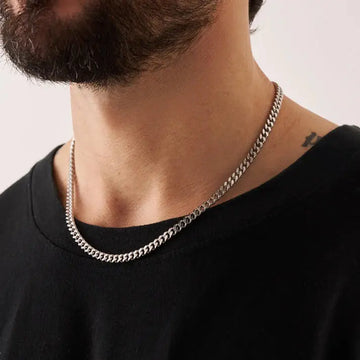Sterling Silver: Pros and Cons:
Pros of Sterling Silver Jewelry:
-
Precious Metal: Sterling silver is considered a precious metal, giving it inherent value. Unlike stainless steel and brass, sterling silver retains its worth over time.
-
Classic Appeal: With its bright gleam and smooth surface, sterling silver rivals gold and platinum in appearance, making it a timeless choice for high-end jewelry.
-
Design Flexibility: Due to its malleability, sterling silver is ideal for creating intricate and beautiful designs. It’s a favorite among jewelers for crafting detailed pieces.
-
Hypoallergenic: Sterling silver, being mostly pure, is a better choice for those with sensitive skin, as it contains less copper or nickel than brass.
-
Durability: While it’s not as hard as stainless steel, sterling silver is strong enough to withstand daily wear if treated properly.
Cons of Sterling Silver Jewelry:
-
Maintenance: Over time, sterling silver may tarnish and require regular cleaning to maintain its shine. It should also be kept away from moisture, such as when showering or bathing.
-
Price: As a precious metal, sterling silver is typically more expensive than brass and stainless steel, making it a higher investment.
Stainless Steel: Pros and Cons:
Pros of Stainless Steel Jewelry:
-
Durability: Stainless steel is incredibly resistant to scratches, corrosion, and tarnishing, making it ideal for everyday wear. It can even withstand exposure to water, which means you don’t need to remove it when showering or washing your hands.
-
Low Maintenance: Stainless steel is very easy to maintain and doesn’t require regular polishing like sterling silver. It maintains its shine and appeal with minimal effort.
-
Affordability: As a non-precious metal, stainless steel is more affordable than sterling silver. This makes it an excellent option for those on a budget.
-
Versatility: While stainless steel jewelry is often found in minimalistic designs, it can be used for a range of styles. It offers a sleek, modern look that works well with casual or professional outfits.
-
Skin Sensitivity: Stainless steel is hypoallergenic and can be a good option for those sensitive to brass or other metals that contain higher amounts of nickel.
Cons of Stainless Steel Jewelry:
-
Limited Design Flexibility: Due to its hardness, stainless steel can be challenging to work with for intricate or detailed designs. As a result, you’ll often find stainless steel jewelry in simpler, minimal styles.
-
Aesthetic: While stainless steel has a sleek, modern look, it doesn’t have the same warmth and shine as sterling silver or gold, which may not appeal to those looking for a more traditional, luxurious finish.
Brass: Pros and Cons:
Pros of Brass Jewelry:
-
Affordability: Brass is the least expensive of the three materials. It’s often used for fashion jewelry because it offers an attractive gold-like appearance without the high price of actual gold.
-
Design Potential: Brass can be easily shaped into intricate designs, making it ideal for bold, creative, and fashion-forward jewelry pieces. It’s commonly seen in statement rings, necklaces, and bracelets.
-
Lightweight: Brass jewelry is generally lightweight, making it comfortable to wear for extended periods.
Cons of Brass Jewelry:
-
Tarnishing and Oxidation: Brass is prone to oxidation, which means it can develop a greenish patina over time, especially when exposed to moisture, air, or acidic skin. Brass jewelry needs more maintenance than sterling silver or stainless steel.
-
Skin Sensitivity: Some people are sensitive to brass and may experience skin irritation or a greenish stain on their skin, especially with rings or bracelets. This occurs due to the copper content in brass.
-
Less Durable: While brass is relatively durable, it’s more susceptible to scratches and wear than stainless steel or sterling silver, making it less ideal for daily wear.
Sterling Silver vs Stainless Steel vs Brass Jewelry: Which Should You Choose?
-
Best For: Those looking for a precious metal with timeless appeal and lasting value. It’s a great choice if you want something elegant that will stand the test of time.
-
Ideal For: Special occasions, high-quality designs, and those who prefer hypoallergenic materials.
-
Style: Perfect for classic, sophisticated jewelry with intricate designs.
-
Best For: People seeking durable, low-maintenance jewelry that is great for daily wear.
-
Ideal For: A minimalist, modern aesthetic that requires less upkeep and is suitable for those with active lifestyles.
-
Style: Works well for sleek, simple designs that require strength and durability.
-
Best For: Budget-conscious individuals who want stylish, trendy jewelry that mimics gold.
-
Ideal For: Occasional wear or fashion-forward accessories, especially if you’re looking for unique, statement pieces.
-
Style: Best suited for fashion jewelry with bold designs, but should be maintained properly to avoid oxidation.
Conclusion: Which Metal Is Right for You?

The decision between sterling silver, stainless steel, and brass depends on your style preferences, budget, and lifestyle needs. Sterling silver is perfect for those who want a precious metal that offers elegance and lasting value. Stainless steel is ideal for those who need durable, low-maintenance jewelry for everyday wear. Brass is a fantastic option for those who love trendy, affordable pieces with a golden hue.
FAQs:
- Does brass jewelry turn green?
- Can I shower with stainless steel jewelry?
- How do I care for sterling silver jewelry?





























































